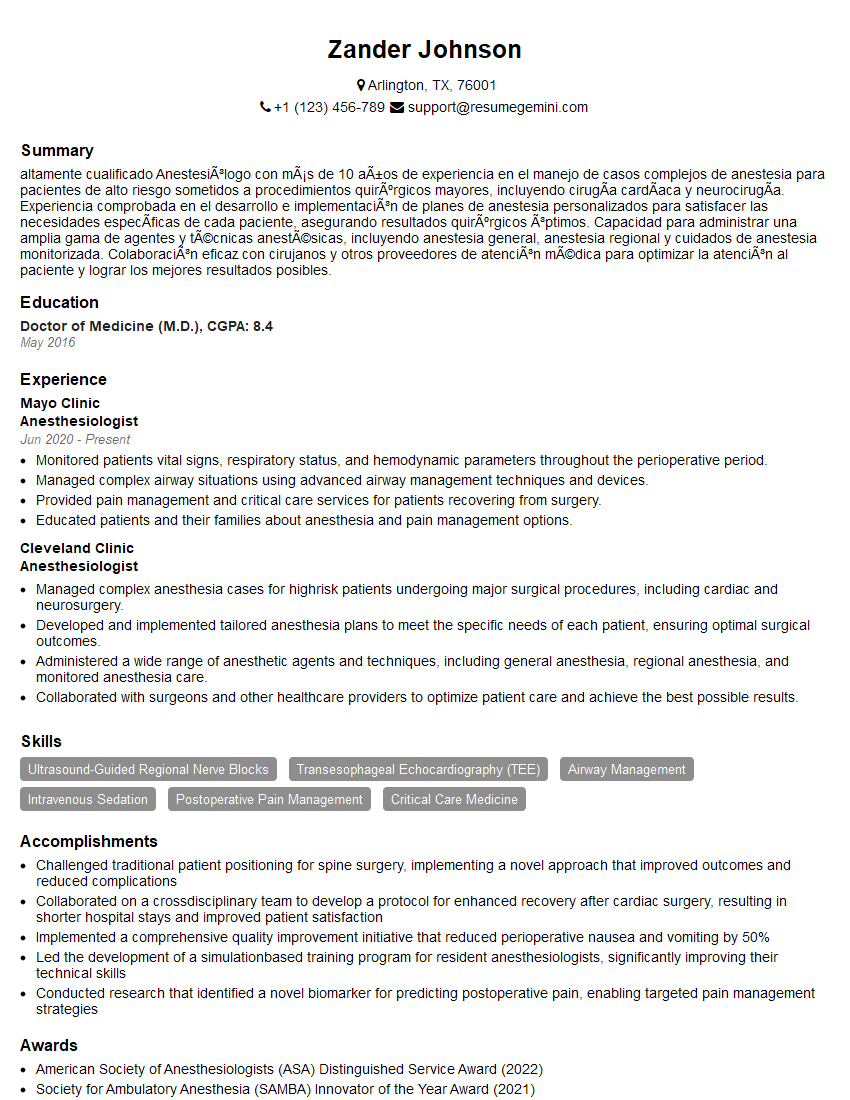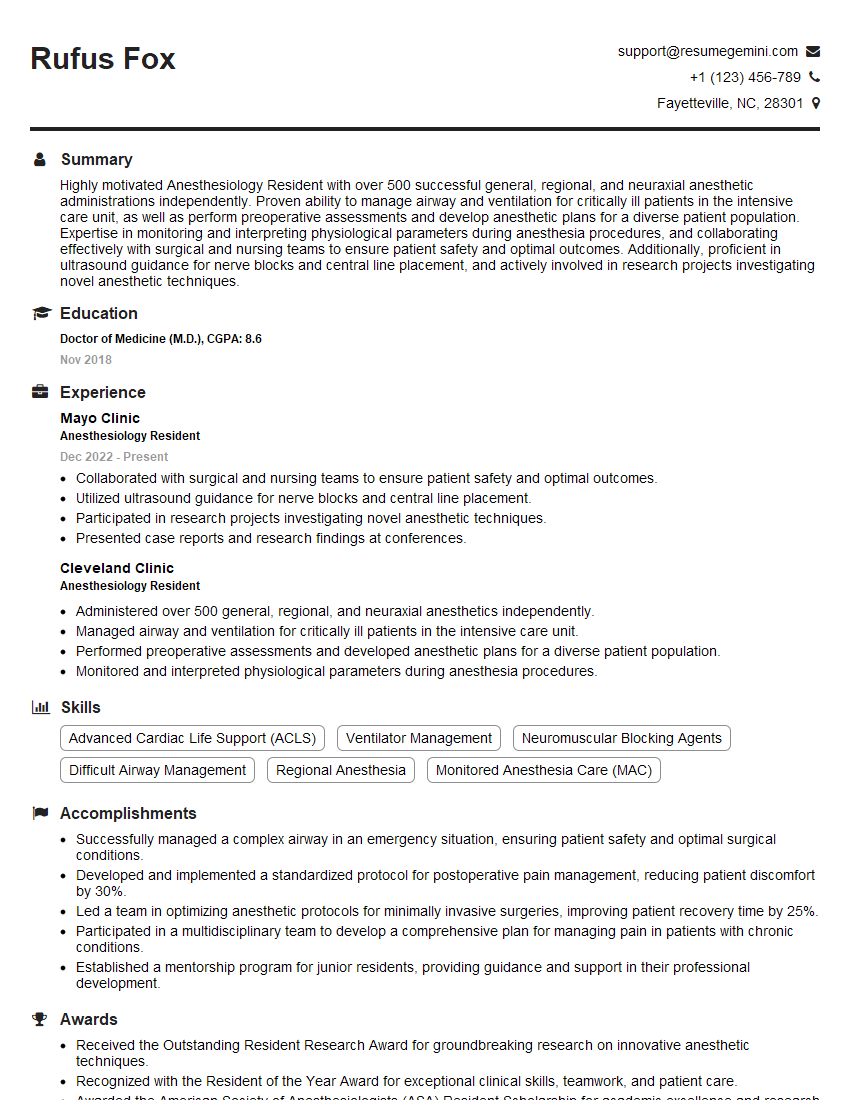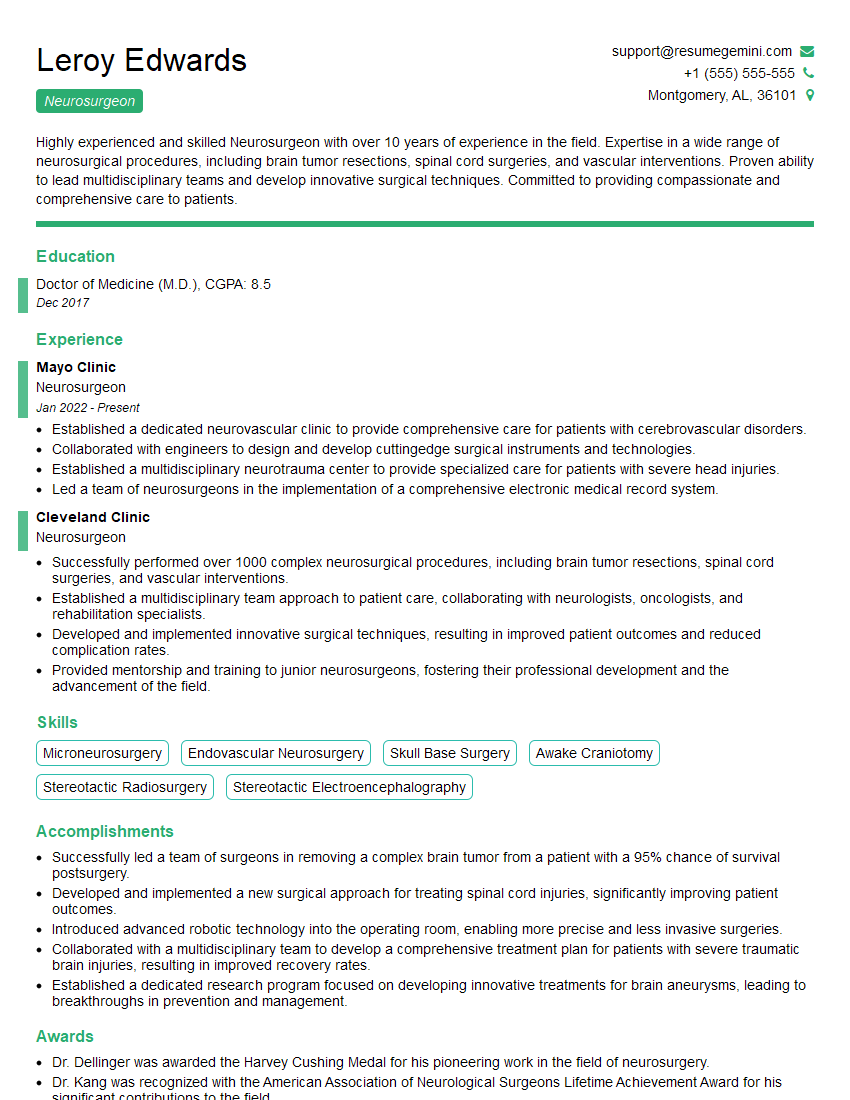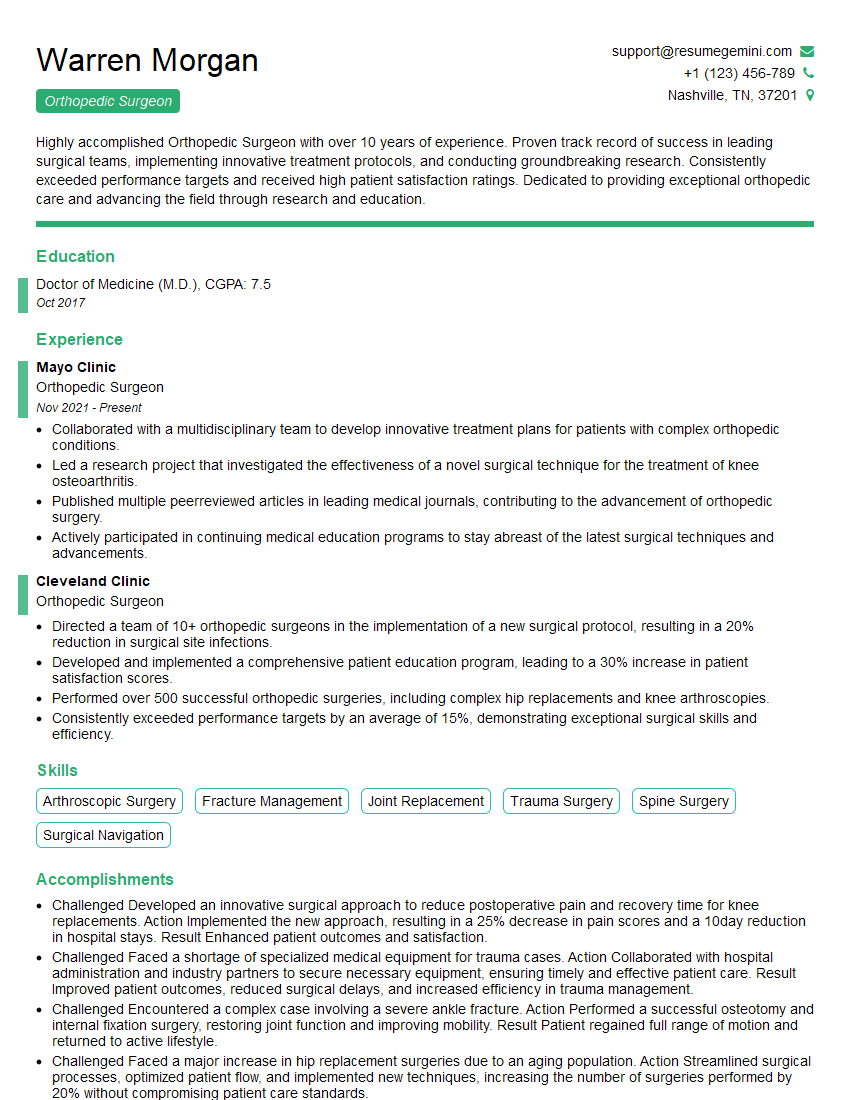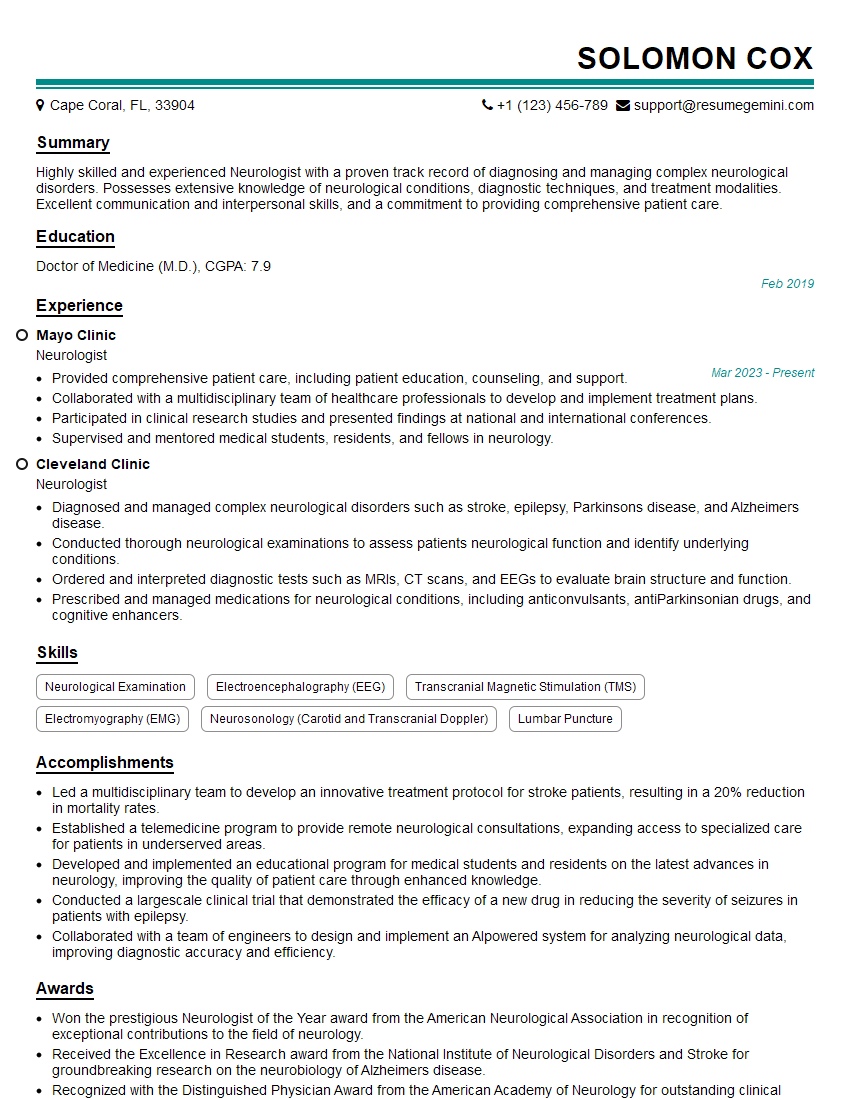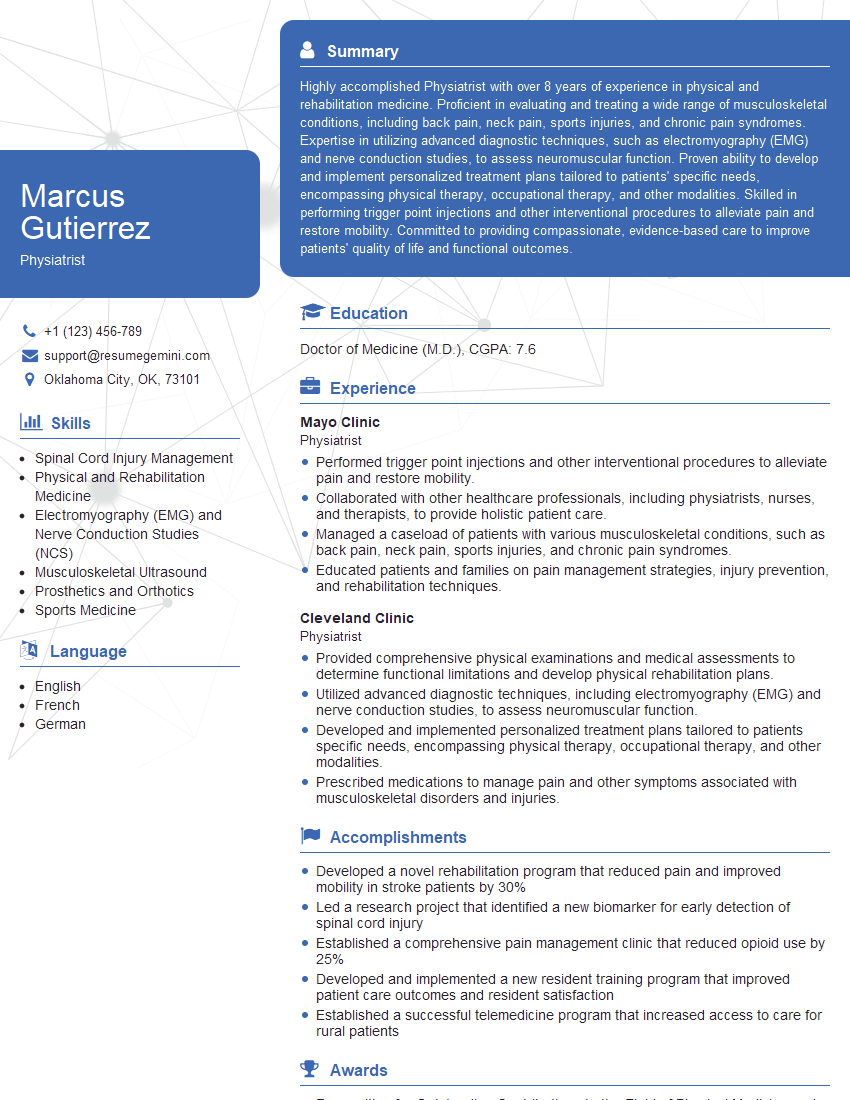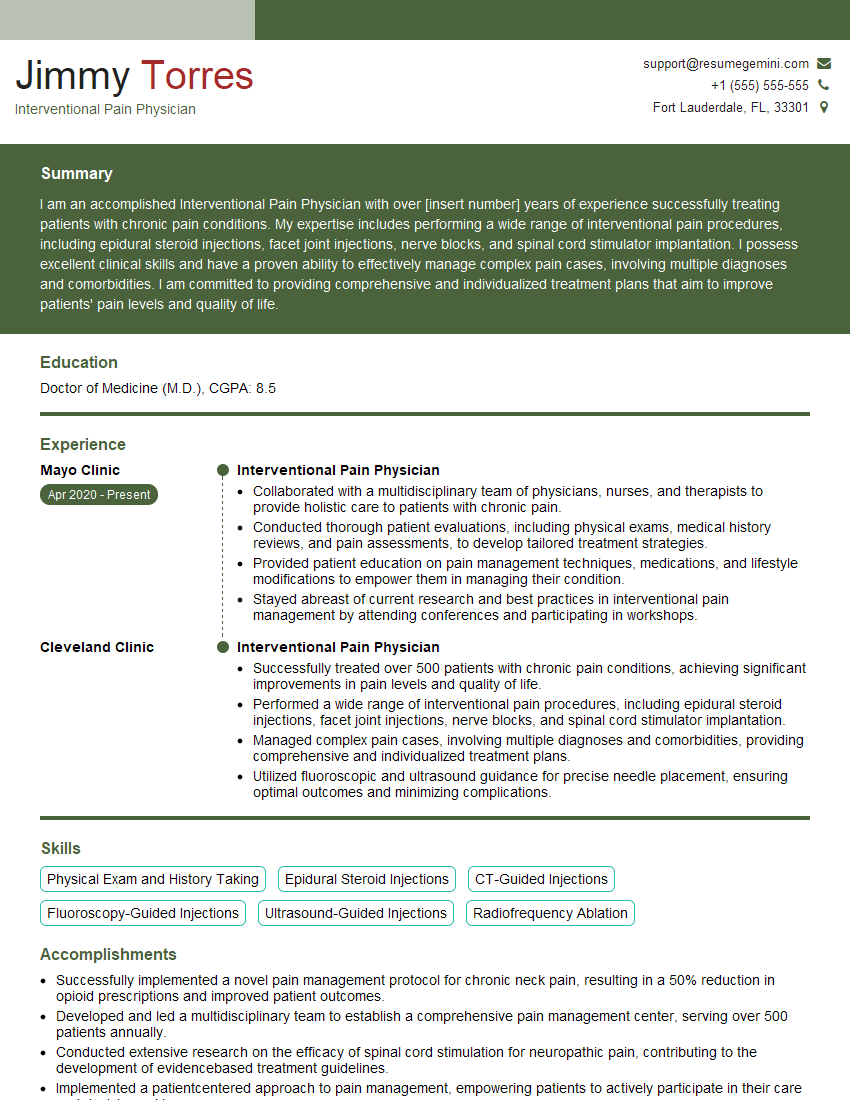The right preparation can turn an interview into an opportunity to showcase your expertise. This guide to Genicular Nerve Blocks interview questions is your ultimate resource, providing key insights and tips to help you ace your responses and stand out as a top candidate.
Questions Asked in Genicular Nerve Blocks Interview
Q 1. Describe the anatomical landmarks for performing a genicular nerve block.
Accurate anatomical landmark identification is crucial for a successful and safe genicular nerve block. We’re targeting the branches of the genicular nerves, which innervate the knee joint. Key landmarks include the palpable medial and lateral joint lines of the knee, the tibial and fibular heads, and the popliteal fossa. The posterior approach relies heavily on the popliteal crease as a reference point. The medial and lateral joint lines help guide needle placement during the anterior approach. Think of it like this: the joint line is your road, and the nerve branches are your destination. You need to navigate carefully to reach the target without damaging surrounding structures.
- Medial Joint Line: Felt on the inner aspect of the knee.
- Lateral Joint Line: Felt on the outer aspect of the knee.
- Tibial Tubercle: The bony prominence below the patella.
- Popliteal Fossa: The diamond-shaped area behind the knee.
Q 2. What are the different approaches to performing a genicular nerve block?
Several approaches exist for genicular nerve blocks, each with its advantages and disadvantages. The choice of approach depends on factors such as patient anatomy, the target nerve branch(es), and the practitioner’s experience. The most common approaches are:
- Posterior Approach: This approach targets the nerves within the popliteal fossa. It’s often preferred for its relatively straightforward access and ability to block multiple branches simultaneously. The needle is inserted just superior to the popliteal crease and guided towards the target nerves using ultrasound or fluoroscopy.
- Anterior Approach (Medial and Lateral): This approach involves inserting the needle at the joint line, medial or lateral. This technique offers more precise targeting of specific nerve branches but may require more anatomical knowledge and a higher degree of skill.
- Superficial Perineural Injection: This newer technique focuses on injecting local anesthetic around the superficial branches of the genicular nerves close to the skin, minimizing potential complications associated with deeper injections.
The selection of the approach requires a careful consideration of the patient’s condition and anatomical factors.
Q 3. What are the indications for a genicular nerve block?
Genicular nerve blocks are primarily indicated for pain management related to the knee. These blocks are valuable for diagnosing and treating various conditions. For example, imagine a patient experiencing persistent knee pain after an injury, where the source of the pain is difficult to pinpoint. A genicular nerve block can be used diagnostically to determine if the pain originates from the knee joint itself. If the pain is alleviated by the block, it suggests a positive diagnostic result indicating a joint origin for the pain. Therapeutically, the block provides pain relief, facilitating rehabilitation and reducing the need for opioids in the short-term.
- Post-surgical knee pain: Managing pain after knee arthroscopy or arthroplasty.
- Osteoarthritis pain: Providing temporary pain relief for patients with severe osteoarthritis.
- Post-traumatic knee pain: Reducing pain following injuries like ligament tears or fractures.
- Diagnostic purposes: Determining the source of knee pain.
Q 4. What are the contraindications for a genicular nerve block?
As with any invasive procedure, genicular nerve blocks have contraindications. These contraindications include:
- Infection at the injection site: Introducing anesthetic into an infected area could spread the infection.
- Allergy to local anesthetic: A history of allergic reactions to local anesthetics is a significant contraindication.
- Coagulation disorders: Increased risk of bleeding and hematoma formation.
- Patient refusal: Informed consent is paramount; the procedure should never be performed against the patient’s will.
- Neurological deficits affecting the injection site: Pre-existing neurological conditions could complicate the procedure and obscure interpretation of results.
A thorough review of the patient’s medical history is essential before performing a genicular nerve block to identify and manage these risks effectively.
Q 5. What imaging modalities are used to guide genicular nerve blocks?
Imaging guidance significantly improves the safety and success rate of genicular nerve blocks. Ultrasound and fluoroscopy are the most commonly employed modalities. Ultrasound allows real-time visualization of the needle’s position relative to the nerves and surrounding anatomical structures, minimizing the risk of inadvertent puncture of blood vessels or nerves. Fluoroscopy, on the other hand, provides a different perspective, giving clear anatomical information of bony structures, and is useful for confirming needle placement.
- Ultrasound: Provides real-time imaging, allowing for dynamic adjustment of needle position.
- Fluoroscopy: Offers a different perspective and helps visualize bony landmarks and needle trajectory.
Using these advanced imaging techniques minimizes complications and increases the likelihood of a successful block.
Q 6. Describe the potential complications of a genicular nerve block.
While genicular nerve blocks are generally safe, potential complications can occur. These are generally low-frequency events but require vigilance and careful technique.
- Hematoma: Bleeding at the injection site due to needle puncture of a blood vessel.
- Nerve damage: Direct injury to the nerve during needle insertion.
- Infection: Introduction of bacteria at the injection site.
- Allergic reaction: Hypersensitivity to the local anesthetic used.
- Transient paresthesia: Temporary numbness or tingling in the area.
It’s important to note that the incidence of these complications is minimized by careful technique, appropriate patient selection, and use of imaging guidance.
Q 7. How do you manage potential complications during a genicular nerve block?
Managing potential complications during and after a genicular nerve block requires a proactive approach. Preparation is key; this includes having readily available emergency medications and equipment. Here’s a step-by-step approach:
- Hematoma: Apply pressure to the injection site. If significant, consider surgical evacuation.
- Nerve damage: This is rare, but supportive care (pain medication, physical therapy) may be required. Consult a neurologist if needed.
- Infection: Administer antibiotics, and monitor the patient closely for signs of worsening infection.
- Allergic reaction: Immediate treatment with epinephrine and other supportive measures, if necessary.
- Transient paresthesia: Reassurance to the patient that it is usually transient and resolves spontaneously.
Post-procedure monitoring is crucial to ensure early detection and prompt management of any complications.
Q 8. What are the potential adverse effects of a genicular nerve block?
Genicular nerve blocks, while generally safe and effective for knee pain management, can carry potential adverse effects. These are thankfully uncommon but important to understand.
- Transient paresthesia: This is the most common side effect, characterized by temporary numbness or tingling in the area supplied by the genicular nerves. It usually resolves within a few hours.
- Infection: As with any injection, there’s a small risk of infection at the injection site. Strict aseptic technique is crucial to minimize this risk. We use sterile needles and gloves to reduce infection to a near zero risk.
- Hematoma: Bleeding at the injection site can occur, especially in patients on anticoagulants. This is usually minor and self-limiting, but in rare cases may require intervention.
- Nerve damage: Although rare, accidental injury to a nerve during the injection is possible. This can lead to persistent paresthesia or weakness. Careful anatomical knowledge and precise injection technique are essential to prevent this.
- Allergic reaction: Allergic reactions to the anesthetic agent are possible, though uncommon. Patients are always screened for allergies before the procedure.
- Intravascular injection: Accidental injection into a blood vessel can lead to systemic toxicity from the anesthetic. This is a serious but rare complication, minimized by careful aspiration before injection and use of ultrasound guidance whenever possible.
It’s important to note that the frequency and severity of these adverse effects depend on various factors including the patient’s overall health, the experience of the physician, and the technique used.
Q 9. How do you assess the efficacy of a genicular nerve block?
Assessing the efficacy of a genicular nerve block relies on a multi-faceted approach, focusing on both subjective and objective measures. We primarily look for pain relief.
- Pain score reduction: We use standardized pain scales (like the Visual Analog Scale or Numeric Rating Scale) to measure the patient’s pain levels before and after the block. A significant reduction in pain scores indicates efficacy. For instance, if a patient’s pain level drops from 8/10 to 2/10, it strongly suggests the block is working.
- Functional improvement: We assess the patient’s ability to perform activities of daily living (ADLs) such as walking, climbing stairs, and bending. Improved functional capacity after the block reflects successful pain management.
- Medication reduction: A decrease in the need for oral analgesics or other pain medications is a positive indicator of the block’s effectiveness. We track medication usage pre and post procedure.
- Patient feedback: Subjective patient reports regarding their pain levels and overall well-being are also crucial. We frequently follow up with patients in the days and weeks after the block.
It’s important to remember that the effectiveness of a genicular nerve block can vary depending on the cause and nature of the knee pain. It is not a cure, and its effects are typically temporary. Long term results are not guaranteed and the patient must be fully aware of this.
Q 10. What are the alternative treatments for patients who are not candidates for a genicular nerve block?
Several alternative treatments exist for patients who aren’t suitable candidates for a genicular nerve block, perhaps due to contraindications like bleeding disorders or allergy to local anesthetic. These options are tailored to the specific cause of the knee pain.
- Physical therapy: A comprehensive physical therapy program focusing on strengthening, range of motion exercises, and gait training can significantly improve knee pain and function.
- Medication: Oral analgesics (NSAIDs, acetaminophen, opioids), topical creams, and intra-articular injections of corticosteroids or hyaluronic acid can provide pain relief. The choice of medication depends on the patient’s condition and tolerance.
- Other nerve blocks: Other nerve blocks targeting different nerves around the knee, such as the femoral or obturator nerve, could be considered, depending on the pain generator.
- Surgery: In cases of severe, intractable pain or underlying conditions such as osteoarthritis requiring structural changes, surgical intervention like arthroscopy or joint replacement may be necessary.
- Radiofrequency ablation: This procedure uses heat to destroy nerves, offering longer-lasting pain relief than a nerve block but with potentially more side effects.
The selection of the most appropriate alternative treatment involves a thorough assessment of the patient’s condition, risk factors, and preferences. A multidisciplinary approach often provides the best results.
Q 11. Discuss the selection criteria for patients suitable for a genicular nerve block.
Patient selection for a genicular nerve block is crucial to ensure both safety and efficacy. Not everyone is a good candidate. We carefully assess several factors:
- Diagnosis: Genicular nerve blocks are most effective for pain originating from the knee joint itself, such as osteoarthritis, post-surgical pain, or other inflammatory conditions. It’s less effective for pain stemming from other sources, like referred pain from the spine.
- Pain characteristics: The patient should have primarily localized knee pain, amenable to nerve block intervention. Widespread pain or pain radiating far from the knee is not ideal for this procedure.
- Patient expectations: Patients must understand that a genicular nerve block is a diagnostic and therapeutic procedure aimed at providing temporary pain relief. It’s not a cure. Realistic expectations are vital.
- Medical history: Contraindications include bleeding disorders (increased risk of hematoma), infection at the injection site, allergy to local anesthetics, and uncontrolled systemic diseases.
- Imaging studies: Imaging studies like X-rays or MRI may be performed to evaluate the underlying condition of the knee and confirm the source of pain prior to the block.
A thorough discussion and shared decision-making process with the patient are essential before proceeding with a genicular nerve block. The goal is to ensure the procedure is both appropriate and beneficial for the patient.
Q 12. Explain the process of obtaining informed consent for a genicular nerve block.
Obtaining informed consent for a genicular nerve block is a critical ethical and legal responsibility. This process is not rushed; it requires a comprehensive conversation explaining all facets of the procedure.
- Procedure explanation: I clearly explain the purpose of the block, the technique involved, and what the patient can expect during and after the procedure. I use simple language, avoiding medical jargon as much as possible. I will use diagrams and models to aid visual understanding.
- Risks and benefits: I thoroughly discuss the potential benefits, including pain relief and improved function, along with the potential risks and side effects (as outlined in question 1). We discuss the possibility of failure and explore other options if needed.
- Alternatives: I explain alternative treatment options to the patient, emphasizing that a genicular nerve block is just one possibility. We explore pros and cons of each.
- Questions and answers: I encourage the patient to ask questions and address any concerns they may have. I want them to feel comfortable and well-informed.
- Documentation: Once the patient understands and accepts the information, they sign a written consent form, confirming their understanding and willingness to undergo the procedure. This form is carefully reviewed and documented in the patient’s medical record.
Obtaining informed consent isn’t simply a form to sign; it’s a vital conversation that builds trust and mutual understanding between the physician and the patient, ensuring that the patient is fully empowered in their healthcare decisions.
Q 13. What type of anesthetic agents are commonly used in genicular nerve blocks?
The choice of anesthetic agent for a genicular nerve block is guided by factors such as the patient’s medical history, the anticipated duration of analgesia required, and the potential for side effects. We typically use local anesthetics, and the choice is often tailored to individual needs.
- Lidocaine: A commonly used local anesthetic, lidocaine offers a relatively rapid onset of action and a moderate duration of analgesia. It’s generally well-tolerated.
- Bupivacaine: This provides a longer duration of analgesia compared to lidocaine, often extending for 12-24 hours or longer. It may be chosen when longer lasting pain relief is desired.
- Ropivacaine: Similar to bupivacaine in its duration of action, ropivacaine is often preferred for its lower potential for cardiotoxicity compared to bupivacaine. This is particularly important in certain patient populations.
- Combinations: Sometimes a combination of local anesthetics is used to leverage the strengths of each agent, such as a rapid onset of lidocaine combined with the longer duration of bupivacaine. This would be based on patient specific needs and physician preference.
The specific anesthetic selected is a clinical decision based on the individual patient and the goals of the procedure. The selection must always be reviewed with the patient.
Q 14. What is the typical dosage and volume of anesthetic used in a genicular nerve block?
The dosage and volume of anesthetic used in a genicular nerve block are not standardized and vary depending on several factors, including the size of the patient, the specific anesthetic agent employed, and the physician’s experience and judgment. The dosages aren’t necessarily fixed.
Generally, the total volume of anesthetic solution used is relatively small, typically ranging from 5 to 15 mL. This is given over multiple injections to different genicular nerves. The concentration of the local anesthetic also varies, commonly ranging from 0.25% to 0.5% for bupivacaine or 1% to 2% for lidocaine. Higher concentrations are sometimes used, especially with the addition of steroids, but require careful attention to potential side effects.
It is crucial to reiterate that the dosage and volume are determined on a case-by-case basis, and careful attention to avoid intravascular injection is always paramount. The practitioner must be vigilant in this area.
For example, a smaller patient might receive a lower total volume (e.g., 5-8 mL) of a lower concentration anesthetic (e.g., 0.25% bupivacaine), while a larger patient might receive a higher volume (e.g., 10-15 mL) of a similar or slightly higher concentration. These figures are illustrative, not prescriptive. The decision is personalized for every patient.
Q 15. What are the different types of needles used for genicular nerve blocks?
Needle selection for genicular nerve blocks is crucial for successful and safe procedure. The choice depends largely on patient anatomy and the physician’s preference, but generally falls into a few categories.
- 22-gauge needles: These are frequently used due to their balance of flexibility and strength. They allow for relatively easy navigation through tissue while minimizing trauma.
- 25-gauge needles: These thinner needles offer even less trauma but may require more precise technique and can be more prone to bending, particularly in challenging anatomy.
- Stimulation needles: These are specifically designed for nerve stimulation techniques during the block, and typically have a small insulated shaft with an exposed distal tip for stimulation and injection.
It’s important to note that needle length is also a key factor, determined by the individual patient’s anatomy (discussed in the next question). The choice always involves a risk-benefit assessment of reducing trauma versus ease of navigation.
Career Expert Tips:
- Ace those interviews! Prepare effectively by reviewing the Top 50 Most Common Interview Questions on ResumeGemini.
- Navigate your job search with confidence! Explore a wide range of Career Tips on ResumeGemini. Learn about common challenges and recommendations to overcome them.
- Craft the perfect resume! Master the Art of Resume Writing with ResumeGemini’s guide. Showcase your unique qualifications and achievements effectively.
- Don’t miss out on holiday savings! Build your dream resume with ResumeGemini’s ATS optimized templates.
Q 16. How do you determine the appropriate needle length for a genicular nerve block?
Determining the appropriate needle length is paramount to avoid inadvertent puncture of vital structures and to ensure accurate targeting of the genicular nerves. It’s not a one-size-fits-all answer.
We typically use ultrasound guidance to visualize the nerves and measure the distance from the skin surface to the target nerves. This allows for precise measurement and selection of an appropriate needle length. For example, if the ultrasound shows a distance of 4cm from the skin surface to the medial genicular nerve, a 5-6 cm needle might be selected to provide sufficient reach while accounting for the angle of insertion. This ensures the needle reaches the target while leaving sufficient margin to avoid going too deep.
Consideration of patient build (body mass index) is vital. Obese patients might require longer needles to reach the target nerves, while slimmer patients might only need shorter ones. Always tailor the needle length to the individual, guided by ultrasound imaging.
Q 17. What are the post-procedural instructions for patients who have undergone a genicular nerve block?
Post-procedural instructions are crucial for patient safety and recovery after a genicular nerve block. Clear and concise instructions should be provided, both verbally and in writing.
- Activity Restriction: Patients should be advised to avoid strenuous activities that could stress the knee joint for a period determined by the physician, often 24-48 hours.
- Pain Management: Patients are educated about managing any residual pain or discomfort with over-the-counter pain relievers as prescribed.
- Infection Prevention: They are instructed on proper wound care, keeping the injection site clean and dry. Signs of infection (redness, swelling, increased pain) should be reported immediately.
- Follow-up Appointment: A follow-up appointment is scheduled to assess the effectiveness of the block and discuss further management.
- Driving Restrictions: Patients should not drive until any medication-induced drowsiness or potential effects from the procedure subside.
Clear communication enhances patient compliance and reduces the risk of complications. Providing written instructions reinforces verbal explanations.
Q 18. How do you monitor patients after a genicular nerve block?
Patient monitoring post-genicular nerve block involves a multifaceted approach, prioritizing safety and early identification of any potential adverse events.
- Vital Signs: Blood pressure, heart rate, respiratory rate, and oxygen saturation are monitored, particularly in the immediate post-procedure period. Any significant deviations should be addressed promptly.
- Neurological Assessment: Assessing for any new-onset weakness, numbness, or tingling in the leg or foot is important. Changes should be reported to the physician.
- Pain Assessment: Regular pain assessments allow for effective pain management and evaluation of the block’s success.
- Injection Site Observation: The injection site is monitored for signs of bleeding, hematoma formation, infection (redness, swelling, pus), or unusual sensation.
Monitoring should be tailored to the patient’s individual risk factors and the complexity of the procedure. For instance, patients with pre-existing conditions may require more intensive monitoring.
Q 19. What are the common reasons for failure of a genicular nerve block?
Genicular nerve block failures can stem from various factors, some technical and some anatomical.
- Inadequate Needle Placement: This is a common cause, often resulting from incorrect needle placement relative to the target nerves. Ultrasound guidance can significantly reduce this issue.
- Anatomical Variations: Significant variations in nerve location or branching can make accurate targeting challenging.
- Inadequate Anesthetic Distribution: The spread of anesthetic solution might not be sufficient to encompass all branches of the genicular nerves, resulting in incomplete analgesia.
- Patient-Related Factors: Factors like inflammation or fibrosis around the nerves can hinder anesthetic diffusion, leading to a less effective block.
- Technical Issues: Needle breakage or improper injection technique can impact the success of the block.
Understanding these potential causes allows for a more proactive approach during the procedure and in planning for subsequent management.
Q 20. How do you differentiate between technical failure and anatomical variations in genicular nerve block?
Differentiating between technical failure and anatomical variations in genicular nerve blocks is essential for improving technique and patient outcomes.
Technical failure typically involves issues such as improper needle placement, inadequate injection technique, or use of inappropriate anesthetic concentration. This can often be identified through careful review of the procedural steps, ultrasonographic images (if used), and post-procedure assessment of the patient’s response to the block. For example, ultrasound might show the needle tip far from the target nerve, or the spread of anesthetic might be inadequate.
Anatomical variations, on the other hand, involve differences in the expected anatomy of the nerves. This might include unusual branching patterns, aberrant nerve positions, or the presence of significant fibrosis surrounding the nerves. In these cases, even with excellent technique, achieving complete blockage might be challenging. Ultrasound can be helpful in identifying such variations. Careful review of images and correlation with the patient’s response is key. Sometimes, a repeat block with adjustment of technique or even a different approach might be necessary.
Q 21. Describe the role of ultrasound guidance in genicular nerve blocks.
Ultrasound guidance has revolutionized genicular nerve blocks, significantly improving both accuracy and success rates. It allows real-time visualization of the nerves and surrounding anatomy.
- Precise Needle Placement: Ultrasound provides a clear image of the nerves, allowing the physician to precisely guide the needle to its target, reducing the risk of inadvertent puncture of blood vessels or other structures. This minimizes pain and complications.
- Assessment of Anesthetic Spread: Real-time visualization allows the physician to observe the spread of anesthetic solution around the target nerves. This ensures that the entire nerve structure is adequately covered, maximizing the block’s effectiveness.
- Identification of Anatomical Variations: Ultrasound can reveal individual anatomical variations such as altered nerve branching or position, allowing for adjustment of the injection technique to optimize success.
- Reduced Complications: By precisely targeting the nerves, ultrasound guidance helps to avoid complications such as vascular puncture, nerve damage, and hematoma formation.
In summary, ultrasound guidance enhances the safety and efficacy of genicular nerve blocks, leading to improved patient outcomes. It’s now considered the gold standard for performing this procedure, moving away from landmark-based approaches.
Q 22. Discuss the use of fluoroscopy in genicular nerve blocks.
Fluoroscopy plays a crucial role in genicular nerve blocks by providing real-time imaging guidance, ensuring accurate needle placement and minimizing the risk of complications. It allows the physician to visualize the needle’s trajectory as it approaches the target nerves, the genicular branches of the obturator, sciatic, and femoral nerves, located around the knee joint. Without fluoroscopy, especially in patients with complex anatomy or obesity, accurate needle placement would be significantly more challenging and prone to error.
Think of it like using a GPS for navigation. Instead of blindly searching for your destination, fluoroscopy provides a visual map, guiding the needle precisely to the target nerves. This minimizes the risk of accidental puncture of blood vessels or other sensitive structures.
Fluoroscopy also allows for confirmation of the anesthetic spread around the target nerves, ensuring adequate coverage for pain relief. We look for a characteristic spread of contrast medium around the joint. If the spread isn’t optimal, we can adjust the needle position to improve coverage.
Q 23. Compare and contrast the different approaches to genicular nerve blocks (e.g., anterior vs. posterior).
Genicular nerve blocks can be approached anteriorly or posteriorly, each with advantages and disadvantages. The anterior approach typically targets the anterior branches of the genicular nerves via a relatively superficial insertion point. It’s generally considered easier to perform and involves less risk of penetrating the joint capsule. However, the anterior approach may provide less complete coverage of all the genicular nerves.
The posterior approach targets the posterior genicular branches and often requires a deeper needle insertion, potentially increasing the risk of joint penetration. However, this approach is often preferred for more complete coverage of all genicular branches, providing more comprehensive pain relief. The choice depends on the individual patient’s anatomy, the specific pain location, and the physician’s experience and preference.
Imagine the knee as a clock face. The anterior approach might target the 12 o’clock and 6 o’clock positions, while the posterior approach aims for the 9 o’clock and 3 o’clock positions. Both are important for comprehensive pain relief, but the access point and technique differ.
Q 24. How do you manage a patient experiencing a post-procedural hematoma after a genicular nerve block?
Post-procedural hematoma formation after a genicular nerve block is a potential complication that requires careful management. The initial step is to assess the size and extent of the hematoma, which is often determined clinically by examination and potentially by imaging studies such as ultrasound. Small hematomas typically resolve spontaneously, requiring only observation and monitoring for increasing size or symptoms.
For larger hematomas or those causing symptoms such as pain, increasing size, or neurological compression, more intervention may be necessary. This could include applying a compressive dressing to help control bleeding, or elevating the leg to reduce swelling. In rare cases, surgical evacuation of the hematoma might be considered if there are significant symptoms of compression or bleeding continues.
Close monitoring of vital signs, such as blood pressure and heart rate, is essential. Regular neurological examinations should also be performed to check for any nerve compromise. It is crucial to document the hematoma, its management, and the patient’s response to treatment meticulously.
Q 25. What is the role of nerve stimulation in genicular nerve blocks?
Nerve stimulation plays a vital role in genicular nerve blocks by providing real-time feedback about needle position. By applying a small electrical stimulus through the needle, the physician can elicit characteristic muscle contractions or paraesthesiae (tingling sensations) in the area innervated by the target nerves. This helps confirm that the needle tip is near the correct nerve and avoids inadvertent injection into unintended structures.
The technique involves connecting the needle to a nerve stimulator device. Low-intensity electrical pulses are delivered, and the patient reports any sensations. The physician then adjusts the needle position until the desired response is obtained, indicating proximity to the target nerve. Once appropriate stimulation is achieved, the local anesthetic is injected.
Nerve stimulation significantly improves the accuracy and safety of genicular nerve blocks, reducing the risk of complications and improving the chances of successful pain relief. It’s like using a metal detector to find a specific object – the stimulation provides feedback to guide the needle precisely to the target nerves.
Q 26. Discuss the evidence supporting the efficacy of genicular nerve blocks for specific conditions.
The efficacy of genicular nerve blocks for specific conditions, like osteoarthritis knee pain and post-surgical pain, is supported by a body of clinical evidence. Studies have shown that genicular nerve blocks can provide significant pain relief in these conditions for a period of time, with many patients reporting substantial improvement in functional ability and quality of life. However, the duration of the effects can vary considerably from patient to patient, as well as the type of procedure.
The level of evidence varies across different studies and conditions. Some studies demonstrate statistically significant improvements in pain scores compared to control groups (e.g., placebo injections), while others show more modest effects. The heterogeneity in study designs, populations, and outcome measures makes it difficult to draw universally applicable conclusions. Further high-quality, well-designed studies are needed to fully elucidate the efficacy and long-term effects of genicular nerve blocks across diverse patient populations.
Meta-analyses of multiple studies are often consulted to synthesize the available evidence and provide a more comprehensive overview of the benefits and limitations of this technique. These analyses often show some positive effect, but also highlight the need for further research and patient selection criteria.
Q 27. What are the long-term outcomes associated with genicular nerve blocks?
The long-term outcomes associated with genicular nerve blocks are variable and depend on several factors, including the underlying condition, the patient’s overall health, and the success of the initial procedure. While some patients experience long-lasting pain relief, others may only experience temporary benefit, requiring repeat injections.
Potential long-term complications are rare but may include infections, nerve damage, joint injury, and persistent pain. It’s important to note that genicular nerve blocks are not a curative treatment for conditions like osteoarthritis. Instead, they offer temporary pain management that can improve quality of life and functional ability.
Long-term follow-up studies are limited, and more research is needed to fully understand the long-term effects. These studies should be structured to track pain relief, functional improvements, and potential complications over several months to years following the procedure.
Q 28. How do you document the procedure and post-procedure care for a genicular nerve block?
Meticulous documentation of the genicular nerve block procedure and post-procedure care is essential for both legal and medical reasons. The documentation should include pre-procedure details such as patient demographics, medical history, allergy status, and the reason for the block. The procedure itself needs a detailed description, including the approach (anterior or posterior), the type and amount of anesthetic used, the use of fluoroscopy or ultrasound guidance, nerve stimulation findings, and any complications encountered.
Post-procedure documentation should detail the patient’s response to the block (pain scores, any complications), instructions for post-procedure care, such as activity restrictions, pain management strategies, and instructions for managing potential complications such as hematoma or infection. Follow-up appointments and patient response to any post-procedure care should also be recorded.
A clear, concise, and complete record ensures continuity of care, assists with future management, and provides legal protection. Using a structured template or electronic health record system can ensure consistent documentation and prevent omissions.
Key Topics to Learn for Genicular Nerve Blocks Interview
- Anatomy and Physiology: Detailed understanding of the genicular nerves, their branches, and their relationship to surrounding structures. Consider variations in anatomy and potential pitfalls.
- Indications and Contraindications: Mastering the criteria for selecting appropriate patients and recognizing situations where the procedure is not suitable. Be prepared to discuss risk-benefit analysis.
- Technique and Approach: Thorough knowledge of different techniques for performing genicular nerve blocks (e.g., ultrasound-guided, fluoroscopy-guided). Discuss the advantages and disadvantages of each.
- Needle Placement and Landmarks: Accurate identification of anatomical landmarks and strategies for precise needle placement to minimize complications. Prepare to explain your approach to needle placement.
- Anesthesia Selection: Understanding the properties of various anesthetic agents and selecting the optimal choice for genicular nerve blocks based on patient factors and procedure requirements.
- Complications and Management: Identify potential complications (e.g., nerve injury, hematoma) and demonstrate your understanding of preventative measures and management strategies. Be prepared to discuss case scenarios.
- Post-procedural Care: Outline appropriate post-procedure monitoring, patient instructions, and potential follow-up care. Discuss patient education strategies.
- Imaging Interpretation: Develop your ability to interpret ultrasound or fluoroscopy images related to genicular nerve blocks. Practice image analysis and identification of relevant anatomical structures.
- Evidence-Based Practice: Demonstrate familiarity with relevant clinical studies and guidelines supporting the use of genicular nerve blocks. Be prepared to discuss current research and best practices.
Next Steps
Mastering Genicular Nerve Blocks significantly enhances your expertise in pain management and opens doors to specialized roles and advanced career opportunities. To maximize your job prospects, create a compelling and ATS-friendly resume that highlights your skills and experience effectively. ResumeGemini is a trusted resource that can help you build a professional resume tailored to the specific requirements of pain management positions. Examples of resumes tailored to Genicular Nerve Blocks expertise are available to guide you through the process. Take the next step in your career journey today!
Explore more articles
Users Rating of Our Blogs
Share Your Experience
We value your feedback! Please rate our content and share your thoughts (optional).
What Readers Say About Our Blog
This was kind of a unique content I found around the specialized skills. Very helpful questions and good detailed answers.
Very Helpful blog, thank you Interviewgemini team.
